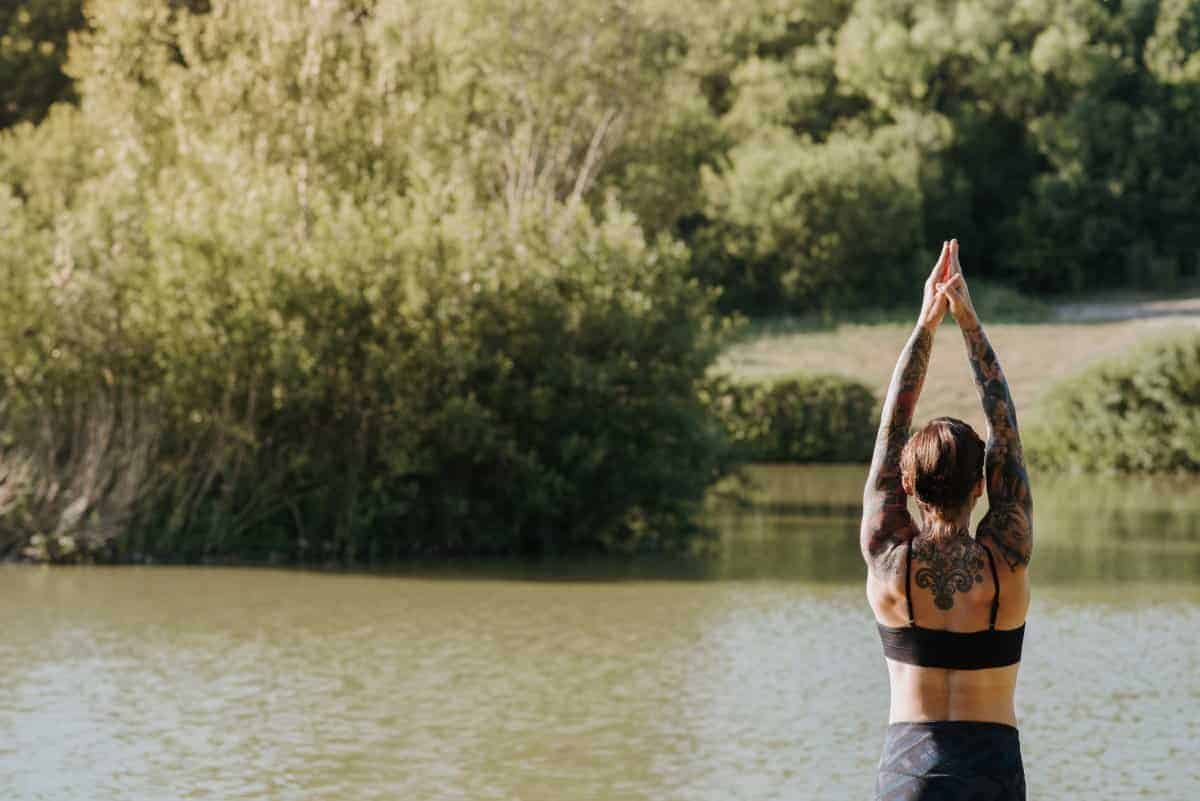Have you ever felt the energy in a room or another person that just felt off? Often when someone starts talking about energy or vibes, they are dismissed as “woo woo”. But the truth is that everything in life is pure vibrational energy, including every part of our body.
Yoga philosophy talks a lot about energy, Qi (chi), or prana and how it flows through your body. From chakras to meridians to nadis to auras, there is undoubtedly an abundance of philosophies about how energy actually flows through the human body. Many of these yogic concepts are spiritual in nature but are also rooted in science.
Let’s dive into everything you need to know about the human energy field and how it relates to your yoga practice.
Contents
- 1 What is the Human Energy System in Yoga?
- 2 Best Yogic Lifestyle Changes for Improving Energy Flow and Balance
- 3 Ancient History of Energy Systems
- 4 The Chakra System
- 5 The Role of the Pineal Gland in Energy Flow
- 6 The Meridian System
- 7 Key Takeaways: Overcome Energy Blockages with Yoga and Chakra Alignment
What is the Human Energy System in Yoga?
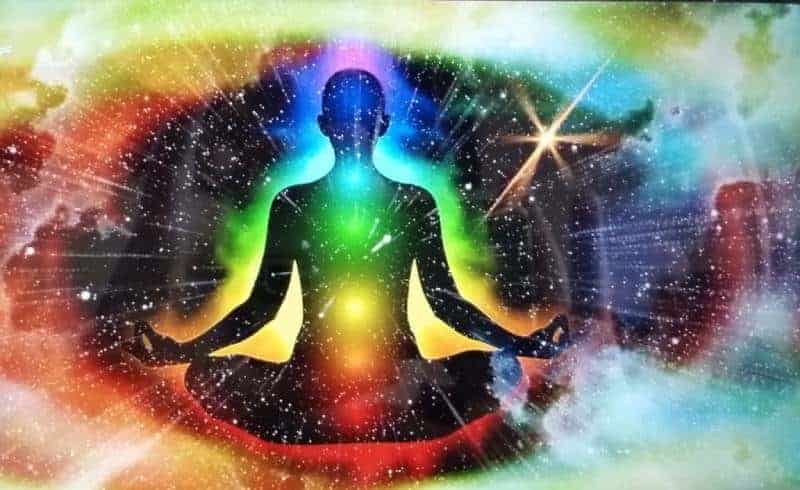
The human energy system is a complex system of physical and spiritual pathways that describe how life force, chi, or prana move through your body. We often think of energy as how much energy we have to do things in our daily lives, but it is also the subtle “vibe” that we radiate to the world around us. It affects every aspect of the universe. The energy flow in your body can be the difference between health or illness, happiness or depression, and balance or disconnection.
For westerners, it’s difficult to understand these intangible forces without spirituality. But there is a surprising amount of scientific evidence to support the different theories of energy systems.
From a yogic perspective, the human energy system generally includes:
- Prana: Prana is the yogic word for life force, vital energy, spiritual energy, or the breath of life. You may be familiar with Pranayama, which is the practice of breathing and circulating energy throughout the body. Prana is thought to be a creative and flowing electric charge that is somewhat like a “sixth sense” of spiritual intuition and physical energy.
- Qi (chi): In ancient Chinese medicine, Qi (pronounced CHEE) is a vital life force that is flowing through everyone and everything at all times. It is the ultimate measure of vitality, health, and balance.
- Chakras: Energy centres or “wheels” of energy that correlate with specific organs, development stages, and emotions. The chakra system originated in India around 500 BCE.
- Meridians: In TCM, these energy channels are pathways for Qi (chi) to circulate through the body. Each meridian has specific acupuncture points along it.
- Nadis: The Sanskrit word naid means “tube” or “flow”. These 72,000 bodily networks carry energy as well as air water, nutrients, blood, and other fluids throughout your body. However, they are not physical structures. They are more like an electromagnetic field that prana can flow through.
- Aura: The electromagnetic field of energy surrounding a body or place. An aura is often described with certain colors to reflect the quality or feeling that surrounds that being or place. It is like a luminous body layer or outline that encompasses you in a net of energy.
Best Yogic Lifestyle Changes for Improving Energy Flow and Balance
Ensuring proper energy flow in a world of high -stress, fast-paced, junk food lifestyles is no easy task. Balancing chakras, meridians, and emitting a positive aura may seem overwhelming. But many of the recommended ancient practices for improving your energy field are actually quite simple.
You can support your energy system by:
- Exercising daily: Movement of any kind is beneficial for your physical body. Ancient humans were not meant to spend hours seated in one place. Walking, lifting weights, stretching, yoga, or any other form of enjoyable movement can drastically reduce stress and improve your mental health. Plus, exercise boosts energy levels and positivity!
- Spending time with Mother Earth: Grounding yourself and spending time outdoors with nature is another simple daily practice for improving energy flow and cultivating a positive, grounded energy. Science shows that simply being near trees or smelling soil can radically reduce your stress levels.
- Doing sun salutations: This 10 minute Surya Namaskar flow is one of the easiest ways to promote healing in your body and get energy flowing throughout your entire body.
- Rest: Quality sleep is essential for balancing your chakras and energy system. Yoga and Ayurvedic philosophy says that sleep is one of the three pillars of strength, vigor, and healthy growth. Yoga is scientifically-proven to improve the quality and amount of your sleep. Learn about Yoga Nidra and the Complete Guide to the Practice of Yogic Sleep.
- Chanting: Vocal inflections and mantras activate the specific frequencies of sound needed for healing and balancing your chakras. Here is how to practice Chakra Mantras and Chants.
Ancient History of Energy Systems
For over 3,000 years, Ayurvedic Medicine (in India) and Traditional Chinese Medicine (TCM in China) has been the basis of natural healing of the physical body as well as spiritual challenges, mental struggles, and emotional trauma. Both systems of healing have a very vital energetic component that affects your health from your cells to your overall bodily function to your spiritual capacity.
For example, energy flow can be biological in your mitochondria (cellular energy centers) or the enzymes your body releases to break down food. Subtle energetics can also relate to the nature of certain seasons, moon phases, and the state of your feelings.
In yoga, the energy systems are rooted in a mind-body-spirit connection. As we move through yoga poses and meditations, you can feel and visualize the energy flow (or blockage) in different parts of your body.
The Chakra System
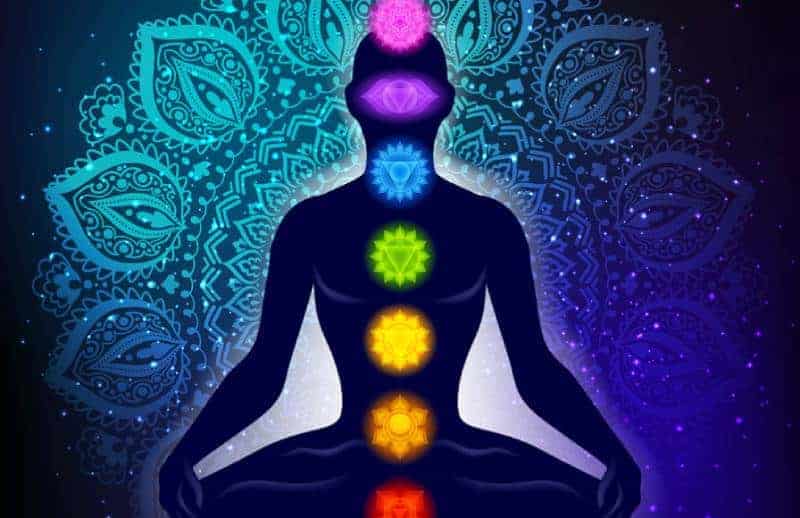
The easiest place to begin understanding energy is with the chakra system. In Sanskrit, chakra means “wheel”. Chakras are the most well-known form of energy in western yoga because we can easily visualize them as relating to different physical positions along the spinal cord. Each chakra is correlated with its own colors, organs, mantras, crystals, frequencies, elements, feelings, and symbols.
While we most commonly refer to 7 chakras, some philosophers assert that there are 12, 15, or 114 chakras, including transpersonal and subpersonal chakras. The Core 7 Chakra System includes:
- Root Chakra: Also known as Muladhara, this base chakra is located at the very bottom of your spine and governs security, safety, and groundedness.
- Sacral Chakra: Also known as Svadhisthana, the second chakra is found below your navel near your reproductive organs. It is linked to pleasure, intimacy, passion, emotions, and creativity.
- Solar Plexus Chakra: Manipura, or the solar plexus, is the third chakra found in your upper abdomen. It is responsible for strength, courage, personal power, resilience, and self-confidence.
- Heart Chakra: The heart chakra is also called Anahata and is located in the center of your chest. Unsurprisingly, this chakra is all about compassion, empathy, joyfulness, forgiveness, and our ability to give and receive love.
- Throat Chakra: Also known as Vishuddha, the throat chakra is located in the throat or vocal chords where it governs communication and self-expression.
- Third Eye Chakra: Located between your eyebrows in the center of your forehead, the Ajna third eye chakra is where your intuition, inner vision, and imagination are sourced.
- Crown Chakra: Sahasrara, or the crown chakra, is thought to hover above the top of your head. This chakra governs your spiritual connection to the universe and the path toward enlightenment.
Different yoga asansas (poses) activate certain chakras. For example, Tree Pose (Vrksasana) targets the Root Chakra to help you feel more balanced, stable, and alert.
On the other hand, Yogi Squat or Garland Pose (Malasana) opens the Sacral Chakra in your pelvic region to help intimate and creative energy flow more freely.
Learn more in this Beginner’s Guide to Chakra Healing, Alignment, and Balance.
The Role of the Pineal Gland in Energy Flow
The third eye or ajna chakra is arguably one of the most well-known chakras. This ancient “seat of consciousness” has been described by the Hindus, Buddhists, Egyptians, and other ancient cultures. The Egyptians called this the Eye of Ra, and many Eastern philosophers linked the third eye to the evil eye symbolism.
While the third eye may seem like solely a spiritual concept, scientists have discovered that the third eye is closely related to the pineal gland in our brains. The tiny gland is located right in the center of our brains.
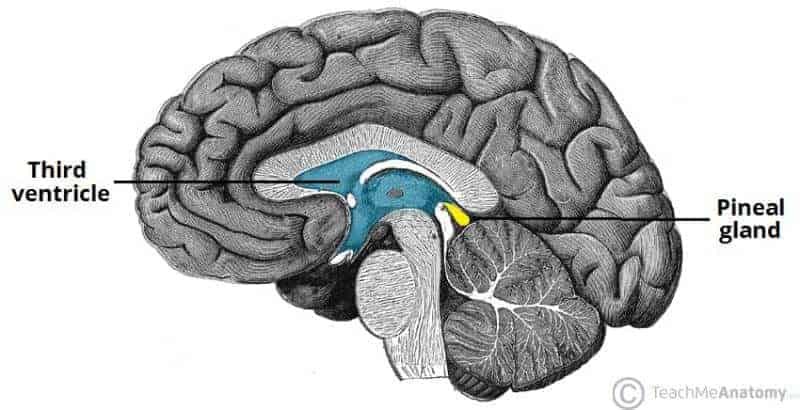
Modern scientists have confirmed that the pineal gland regulates:
- Circadian rhythms (your sleep-wake cycles)
- How your body responds to light
- Key hormones like melatonin (which regulates sleep)
- Cell protection, neuroprotection, and the reproductive system
So what does this have to do with your energy flow in yoga? An improperly functioning pineal gland has been linked to
For example:
- Avoid blue light from screens at night or wear blue-blocking glasses
- Get red light (sunlight) first thing after waking
- Try to get into a regular sleeping routine
- Meditation and nighttime yoga is proven to activate the pineal gland
- Listening to binnaural beats (935Hz) has been shown to stimulate the pineal gland and aid in anxiety, stress, and depression
Learn more in this guide: What is the Third Eye? Science + Spirituality of the Third Eye Chakra.
The Meridian System
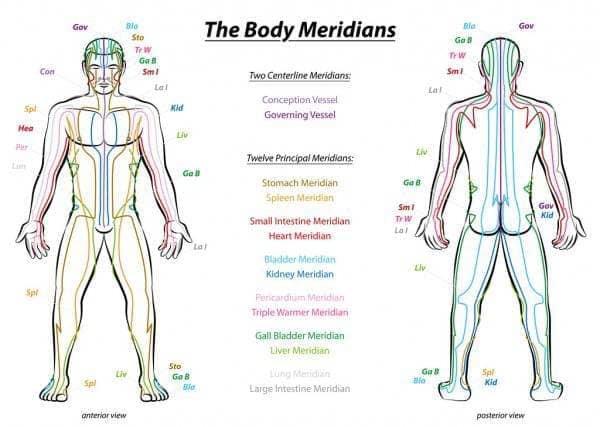
Anyone familiar with acupuncture has probably heard of meridian lines. While these teachings are not as prominent in modern yoga classes, the meridian system is closely related to chakras and energy flow in your yoga practice.
Ancient philosophers of Traditional Chinese Medicine (TCM) first described meridians around 100 BCE. You can think of the meridians as highways systems that map throughout the whole body. They are similar to veins and vessels, or rivers and streams, except that meridians are non-physical.
Each jing-luo (meridian) is a channel that connect organs together and regulate the flow of fundamental substances (Qi, blood, body fluid, essence, and spirit) throughout the body.
Each meridian also has a Yin-Yang pair:
- The yin or passive, female principle (for example, the Yin Lung meridian)
- A corresponding Yang or masculine, active energy (for example, the Yang Large Intestine meridian)
According to this ancient healing practice, Qi energy flows through the 2 central meridians and then the 12 principal meridians in the body. Acupuncture, massage, dry needling, and Yin Yoga sequences are used to balance and open energy flow in specific meridians.
Learn more about meridians and Qi in this guide: What is Chi Energy + How to Balance Your Qi for Personal Transformation.
Key Takeaways: Overcome Energy Blockages with Yoga and Chakra Alignment
Ultimately, energy flows in the human body in a circulatory framework. But specific blockages in your chakras, muscles, or meridians can lead to imbalance. The way you feel and think directly affects your energetic field and aura, as well as those around you.
The easiest place to start is with chakra alignment through asanas. Check out our guide to Chakra Yoga: How To Align Your Chakras With Yoga Poses.
Namaste!


